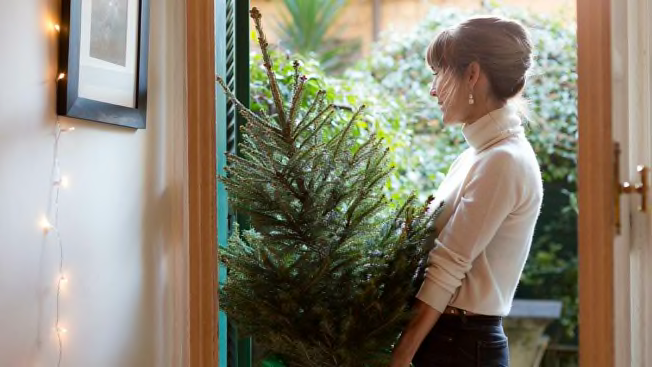Have You Ever Heard of a Potted Christmas Tree?
We have the lowdown on these less wasteful but high-maintenance trees

The holiday season is my favorite time of year. In New York, the snow is still in its novel phase, all fluffy and soft. My Brooklyn neighborhood decks out the main thoroughfare in charming string lights, and a house down the block goes all-out on a sweet nativity scene that makes my chilly winter dog walks something to anticipate. My window at home glitters with a menorah; beside it is a painstakingly chosen and decorated Christmas tree.
But January is a cruel reminder that winter, in fact, royally sucks. The holidays are over, and instead of lovely decorations, the streets are littered with browning Christmas trees reminiscent of a drunk passed out on the curb on a Sunday morning. It’s tragic. It’s a horrible way to begin the year. There is, however, a solution: potted Christmas tree rentals.
Should You Get a Potted Christmas Tree?
The first advantage to a potted Christmas tree is emotional, which is a perfectly good reason, particularly around the emotionally charged holiday season. If you get depressed by throwing a beloved Christmas tree on the curb (or even composting it, the eco-friendly alternative that’s available in many regions), getting a potted Christmas tree helps absolve some of the guilt and pain involved in dragging the tree downstairs and letting it languish on the sidewalk for days before pickup.
“Every year we attempt to retrieve the trees, putting them all back in the mountains to keep alive for another eleven months until the following Christmas season,” says Eric Manning, owner of Plantman.com in California, who has been renting trees for 30 years.
Some companies, including Manning’s, allow you to rent the same tree year after year, in which case the tree quite literally grows alongside your family. Manning says his company carefully prunes each tree “like bonsai,” so that the trees are the ideal shape for people’s homes. “I want the perfect ratio of height to width, so I shape all varieties, including redwood, spruce, fir, and cedar,” he says.
The other advantage is that potted trees are one of the most sustainable ways to decorate your home for Christmas. Although cut Christmas trees are not as horrible for the environment as many imagine, a potted tree, whether rental or owned, has long-term environmental benefits over artificial trees in particular. Folks at Consumer Reports like artificial Christmas trees, but we have pretty strict requirements for what qualifies as a good one that will last you a long time—the only way to ensure that the reduced environmental impact over time balances out the shipping costs and landfill-bound plastic.
“Artificial trees will likely end up in landfill,” says Bert Cregg, PhD, professor of horticulture at Michigan State University in East Lansing, Mich. Cut trees can be composted into mulch, but “potted trees can be planted in a park or landscape and will continue to capture carbon from the atmosphere—and produce oxygen—as long as they are alive.”
They’re also easier to get home. “Potted trees that are rented often offer the advantage of being delivered, whereas purchasing live trees in containers (or ball-and-burlap) can be considerably heavier than cut live trees or artificial trees,” says Mike Arnold, professor of landscape horticulture and director of The Gardens at Texas A&M University in College Station, Texas. (Ball-and-burlap trees are grown in the ground at the nursery, then dug up and placed in—you guessed it—a burlap bag before transport.)
In the example of the Plantman, trees are gently extracted from the ground, placed in a pot, and delivered to your home, to be picked up a few weeks later and replanted. The company sends along care instructions, which must be followed carefully to ensure that the tree is in healthy condition when it’s time for pickup. Other companies may keep the tree in a pot throughout the year, though according to Chris Enroth, a horticulture educator at the University of Illinois Urbana-Champaign Illinois Extension, they likely need to be repotted in a bigger container each year because, obviously, the tree gets bigger. If you plan to use the same tree each year, that could be a boon—as I wrote earlier, the tree grows along with your kids (if you have them) or simply and beautifully expresses the passing of time as it gets taller. But if your space is limited, in a few holiday cycles the tree may have grown too large for your home, in which case you’ll have to move on to a newer, younger, and smaller tree.
And generally speaking, the prices for a potted tree rental are about what you’d pay for a cut tree (although as you’ll read below, you may not get to keep the tree rental as long as a cut tree). In New York, at least, a 6-foot cut tree costs between $150 and $200; the prices for a potted tree of the same size are about the same, although your local tree prices (both rentals and cut trees) may differ according to availability.
Challenges of a Potted Tree Rental
Despite the many advantages of renting a potted Christmas tree, there are things you should know if you plan to try it out this holiday season.
Con No. 1: They Require Extra Care
Because potted trees are alive, they require TLC just like any potted plant, with an additional wrinkle: The trees are typically going from a cold outside environment to a warm cozy interior, which can convince the tree that it’s spring and time to grow. “If you’re in the northern part of the country where it gets cold, especially at the end of December, beginning of January, one of the issues we see is that if people leave the living tree in the home too long,” Cregg says. In that case, the tree will lose its “cold-hardiness,” which gives the tree its capacity to withstand freezing temperatures for months at a time. If the tree is kept in a warm environment too long, it emerges from dormancy and begins to grow and produce cones for reproduction. “If it’s at home for three or four weeks and then you set it back outside and it’s now the beginning of January and at zero, it’s probably going to kill the tree or at least damage it severely,” Cregg says.
Most real Christmas trees, whether cut or living, should be kept in a cool place rather than right beside the heat vent or radiator, but it’s particularly important for the living (aka potted) tree, to help stave off the tree’s assumption that it’s spring and time to let loose.
For that reason, many companies may require that you only keep your tree inside for a week or two. “What we try to encourage people to do, if you’re in this part of the country at least, is minimize how long people have the tree indoors. Two weeks is probably about as long as you’re gonna want to keep it inside,” says Cregg, whose home in East Lansing, Mich., has an average December low temperature of 20° F. Ken Johnson, a horticulture educator at University of Illinois Urbana-Champaign Illinois Extension, says that if you’re planning to have the tree longer than that, keeping the tree in a garage or covered porch before bringing it inside and placing it back out there when its time is up can help the tree survive the temperature shifts.
Just like a regular potted plant, you’ll need to make sure that the tree is getting plenty of water. “The root ball on a potted tree should be kept moist but not soggy,” Arnold says. And you’ll want to pay attention to its needles, which, like the soil, need to remain moist. Arnold says: “Avoid locations with drafts that might dry the foliage, and use LED lights which produce less heat than incandescent Christmas bulbs.”
Keep in mind: if you damage or kill the tree, you might be liable for its replacement cost. Ask your tree rental company what its policies are before you commit.

Photo: Kathrin Ziegler/Getty Images Photo: Kathrin Ziegler/Getty Images
Con. No. 2: They're Heavy
You also want to keep in mind that depending on how often you include weightlifting in your regular workout routine, you might not be able to bring that tree into the house yourself. “A potted tree is much heavier than a cut tree as it has a sizable root ball, soil, and the pot to sustain the tree,” says Tim O’Connor, executive director of the National Christmas Tree Association, a trade group dedicated to Christmas tree growers. Arnold says that a potted Christmas tree can be 20 to 25 pounds heavier than a cut tree, meaning that a 50-pound, 6-foot Christmas tree just gained some holiday weight. Rental companies may deliver the tree to the exact spot in your home where it will rest for the holiday, but it’s wise to check before pressing “order,” just in case.
Con No. 3: They’re Not Widely Available
. . . At least not as widely available as cut trees. “The vast majority of the listings you find are for California or the West Coast,” Arnold says. That’s perhaps not a surprise; when I asked my mom, a botanist based in California, if she’d heard of Christmas tree rentals, she said she had, though she hadn’t ever gotten one. But I don’t know anyone on the East Coast who has rented a potted tree, despite the fact that so many people my age in New York and the surrounding areas get so many things delivered to our apartments.
If you can’t find any Christmas tree rentals in your area, ask your local Christmas tree farm whether they’ve considered renting trees in pots. It’s possible that if enough people inquire, they’ll make it happen next year.
Con No. 4: You Will Need to Protect Your Floor or Furniture
Arnold says it’s important to know exactly what you’re getting before you get it, such as a water saucer. “You also wanna make sure that you have something underneath that plant so that you’re not ruining whatever floor or furniture surface that it’s sitting on,” he says.
If you want to get a potted Christmas tree this year, just remember living trees aren’t used to being shuttled into a warm home and then back out into the cold a month later. Keep it brief, give it the care and love it deserves, and when you place your order with the Christmas tree rental company the following year, it’ll be like connecting with a gracefully aging old friend: they’re a little different, perhaps a bit bigger, and more beautiful than ever.




















